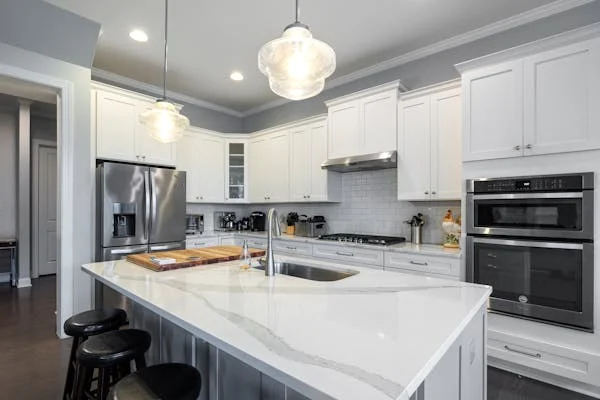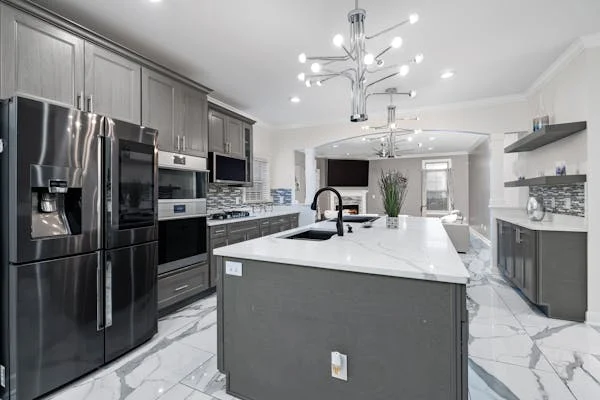
Marble is a beautiful natural stone. People use it in homes, buildings, and sculptures. It has been valued for centuries. Its smooth surface and unique patterns make it a top choice. But how does marble form? What are its properties? This guide will help you understand marble better.
How is Marble Formed?
How is a marble formed? It starts as limestone. Over time, heat and pressure change the limestone in a process called metamorphism. The minerals in the rock transform, becoming tightly packed to create the hard and shiny marble we see today.
The colors and patterns in marble come from different minerals. Pure marble is white, while other colors like gray, pink, and green result from impurities. These impurities make each marble slab unique.
Where is Marble Found?
Marble is found all over the world. Some of the best marble comes from Italy, Greece, and Spain. In the U.S., marble is found in Georgia, Colorado, and Vermont. Many homes in Columbus have marble countertops and floors. If you want to buy marble, you can check local countertop stores. They have different types and styles for your home.
Properties of Marble
Marble is not just beautiful. It has special properties that make it useful. Here are some key features:
1. Hardness and Durability
Marble is strong but softer than granite. If not handled carefully, it may chip or scratch. Sealing marble helps protect it from damage.
2. Unique Patterns and Colors
Each marble slab has different patterns. This makes every piece one of a kind. The natural veining adds beauty to floors, walls, and countertops.
3. Heat Resistance
Marble can handle heat. This is why people use it for fireplaces and kitchen countertops. But placing hot pans directly on it can cause damage over time.
4. Porous Nature
Marble absorbs liquids. If spills are not cleaned quickly, they can leave stains. A good sealant helps prevent this problem.
Uses of Marble
Marble is popular in homes and buildings. Here are some common uses:
1. Countertops
Many homeowners choose marble for kitchen and bathroom countertops. It adds elegance and increases home value.
2. Flooring
Marble floors look luxurious. They stay cool, making them great for warm climates.
3. Walls and Backsplashes
Marble walls give a modern and stylish look. They are used in bathrooms and kitchens for a high-end feel.
4. Sculptures and Monuments
Artists have used marble for centuries. Famous statues like Michelangelo’s David are made of marble. Memorials and gravestones are also made with it.

Caring for Marble
Taking care of marble is easy if you follow some simple steps.
1. Cleaning
- Use a soft cloth and mild soap.
- Avoid acidic cleaners like vinegar and lemon juice.
- After cleaning, pat the surface dry to avoid water stains.
2. Sealing
- Seal your marble once or twice a year.
- This protects it from stains and spills.
- A professional can help with sealing.
3. Avoiding Scratches
- Use coasters under glasses and cups.
- Place mats under heavy objects.
- Do not cut directly on marble surfaces.
Pros and Cons of Marble
Before choosing marble, it’s good to know its advantages and disadvantages.
Pros
- Beautiful and unique appearance
- Adds value to a home
- Heat-resistant
- Classic and timeless
Cons
- Can scratch and chip
- Needs regular sealing
- Stains easily if not cleaned quickly
- Expensive compared to other stones
Choosing the Right Marble for Your Home
If you plan to use marble, consider these tips:
1. Pick the Right Type
There are different types of marble. Some are better for floors, while others are great for countertops. White marble is classic, while darker shades hide stains better.
2. Check the Finish
Marble comes in polished and honed finishes. A polished finish is shiny, while a honed finish is matte. Both look great, but honed marble hides scratches better.
3. Set a Budget
Marble can be costly. Compare prices at different stores. Local countertop stores may have special discounts or offers.
FAQs About Marble
1. Is marble good for kitchens?
Yes, but it needs care. Marble is porous, so it should be sealed regularly to prevent stains.
2. Can I use marble in a bathroom?
Yes! Many people use marble for bathroom floors, walls, and vanities.
3. Does marble crack easily?
Marble is durable but can crack if heavy objects are dropped on it. Proper care helps prevent damage.
4. How often should I seal marble?
Sealing once or twice a year is recommended. It keeps the surface protected.
5. Is marble expensive?
Marble can be costly, but prices vary. Local stores may have budget-friendly options.
Conclusion
Marble is a stunning and valuable stone. It adds beauty and elegance to any space. While it needs care, its benefits make it worth the investment. If you are thinking about adding marble to your home, visit local countertop stores in Columbus. They can help you find the perfect marble for your space.